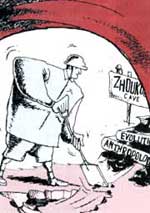A new light
 IF THE findings of an international team of researchers led by Steve Weiner of the Weizmann Institute of Science in Rehevot, Israel, are confirmed, then it is time to rewrite 60 years of anthropology textbooks. The findings will reshape the modern view of Homo erectus, the pre-sumed ancestor of today's humans who are believed to have used fire to sustain migration into the colder regions of Europe and Asia. Evidence from an ancient Chinese cave has cast doubt on prevailing theories about the taming of fire by Homo erectus, suggesting that this epochal achievement occurred much later than scientists have long believed.
IF THE findings of an international team of researchers led by Steve Weiner of the Weizmann Institute of Science in Rehevot, Israel, are confirmed, then it is time to rewrite 60 years of anthropology textbooks. The findings will reshape the modern view of Homo erectus, the pre-sumed ancestor of today's humans who are believed to have used fire to sustain migration into the colder regions of Europe and Asia. Evidence from an ancient Chinese cave has cast doubt on prevailing theories about the taming of fire by Homo erectus, suggesting that this epochal achievement occurred much later than scientists have long believed.
The Zhoukoudian cave near Beijing is widely considered to be the site of the world's oldest known campfire, based on the charred animal bones, antlers and other artefacts from an apparent Homo erectus settlement dating back nearly 500,000 years. But Weiner's team, using a very sophisticated analysis of the cave soils, found no traces of wood ash or other evidence of the use of fire there. "In a sense, we spoil the theory," said Weiner.
Taming fire was the crucial step that enabled early hominids to counter cold and darkness and diversify into tempe-rate and even glacial lands of the north. With doubt being cast on the Zhoukoudian site, the consensus date for the earliest purposeful use of fire moves for-ward by at least 100,000 years. Moreover, the researchers say that the Zhoukoudian cave was never used as a dwelling by human ancestors, contradicting what has been taught to genera-tions of anthropologists since the site was first discovered in the early 20th century.
Evidence of early human ancestors mov-ing into parts of north-ern Europe dates back to 300,000 years, the approximate time of an encampment near Ver-tesszollos in Hungary, where archaeologists found suggestions of a campfire in charred bones arranged in a radial order. With the Zhoukoudian site in question, the Hun-garian site - believed to have been occupied by either Homo heidelbergensis or Neanderthals, both of whom emerged after Homo erectus - now stands as the oldest confirmed evi-dence of the use of fire.
Weiner's team used a variety of instruments to study sediments and other material from the Chinese cave in what was described as the first systemat-ic investigation of Zhoukoudian since its original excavation 70 years ago. The initial excavations had uncovered a range of artefacts and fossilised bones, including some of the best-preserved remains of a Homo erectus ever found, known as the "Peking Man".
Homo erectus, similar to modern humans in several ways, had a thicker skull, a prominent eyebrow ridge and a smaller brain. The remains of Peking Man, however, disappeared during the Japanese invasion of China, though the charred, tool-scarred animal bones con-tinued to be cited as evidence of the taming of fire.
Though Weiner's analysis con-firmed that some of the animal bones in the cave had indeed been burned, there were no signs of ash or ash remains. This, the researchers concluded, amounted to "no direct evidence for in situ fire" in the cave. The red and yellow clays in the cave, which were earlier taken to be evidence of a hearth used for heating or baking, actually were fine sediments deposited by a shallow pond that once covered the cave floor, the researchers contend.
Related Content
- Climate adaptation and its measurement: challenges and opportunities
- Reducing post-harvest losses in India: farmer-level interventions and grain management strategies
- Global EV outlook 2024: moving towards increased affordability
- Sociocultural dimensions in water resources management: policies, practices, and challenges
- Adapting zero-emission vehicle incentives for a mainstream market
- Global food 50/50 report 2023/2024
